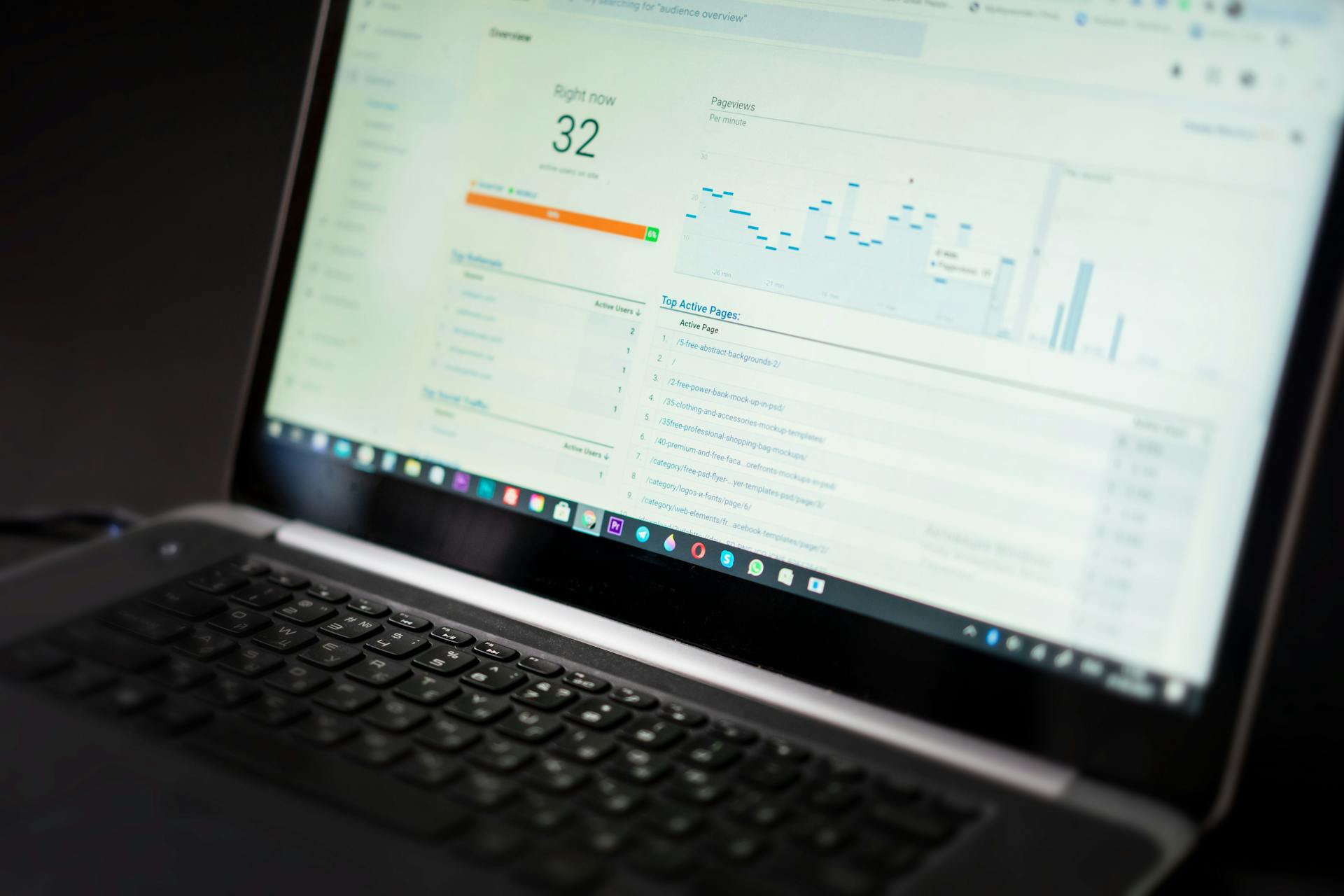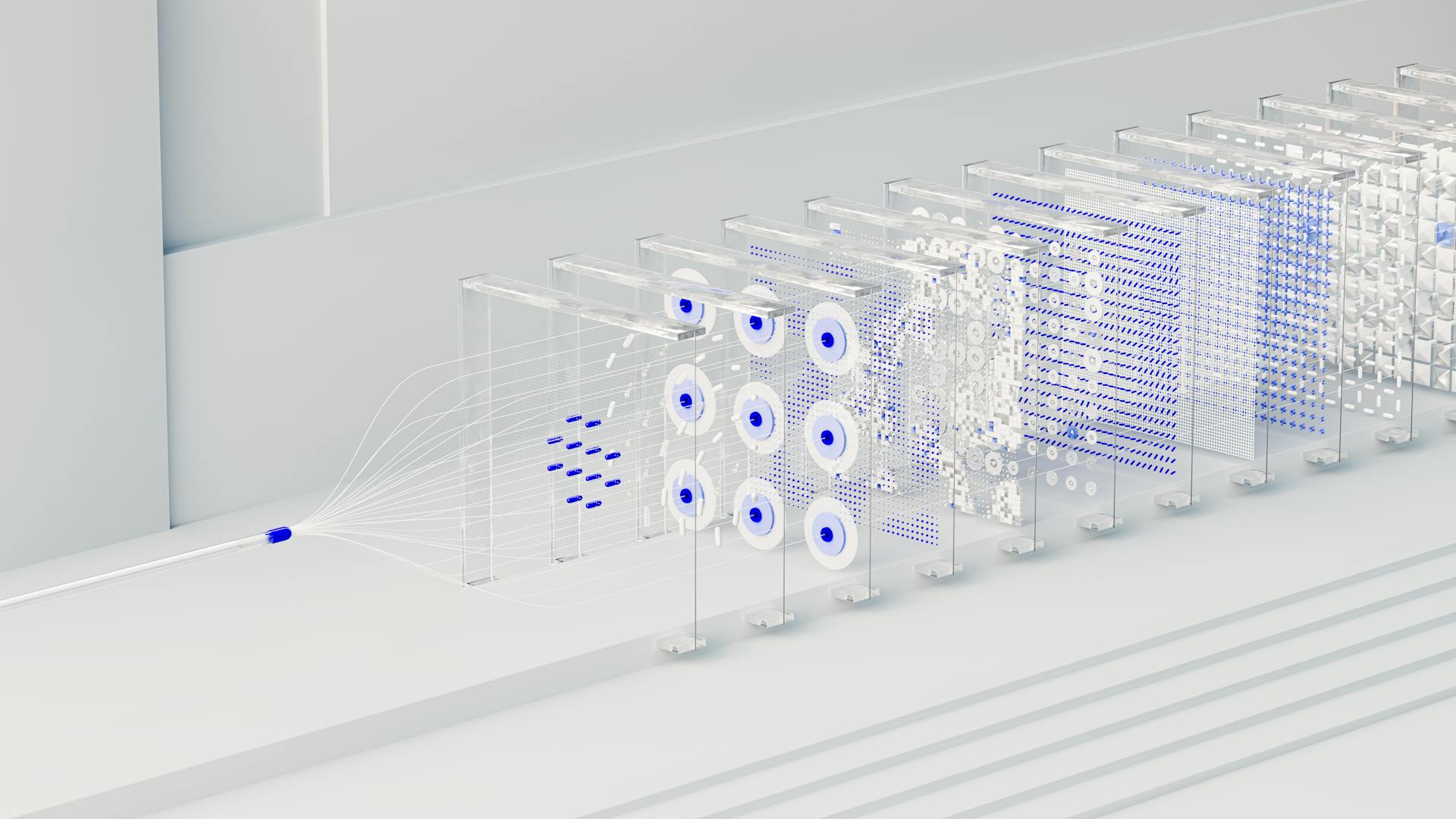
Real-time feature engineering is a crucial aspect of machine learning, and it requires a different set of techniques and best practices compared to traditional batch processing.
In a real-time system, features are generated on the fly, which means they need to be designed to handle high-speed data streams. This requires a focus on simplicity and efficiency.
To achieve this, consider using techniques like aggregations, which can be used to combine data from multiple sources into a single feature. For example, aggregating user behavior data from multiple devices can create a more comprehensive user profile.
Feature selection is also critical in real-time systems, as it helps to reduce the dimensionality of the data and prevent overfitting. By selecting the most relevant features, you can improve the performance and efficiency of your model.
For more insights, see: What Is Labeling Data
Real-Time vs Batch Processing
Batch processing is suitable for non-time-critical tasks, where data is collected and processed in large batches offline. This approach often involves training models on fixed datasets, which can limit the model's ability to adapt to changing conditions.
Real-time ML, on the other hand, enables instant predictions or decisions that require quick responses. It processes data as it arrives, providing immediate responses and allowing for adaptive learning as new data is continuously updated.
Here's a comparison of batch processing and real-time ML:
Differences Between
Real-time and batch processing differ fundamentally in how data is processed. Batch processing collects and processes data in large batches offline, whereas real-time processing handles data as it arrives, providing immediate responses.
In batch processing, data is collected and processed in large batches offline, which makes it suitable for non-time-critical tasks. On the other hand, real-time processing enables instant predictions or decisions that require quick responses.
Batch processing often involves training models on fixed datasets, whereas real-time processing allows models to be updated continuously as new data arrives, enabling adaptive learning. This means that real-time processing can adapt to changing patterns and trends in the data, whereas batch processing is limited to the data it was trained on.
A unique perspective: Time Series Feature Engineering
Here's a summary of the key differences between batch and real-time processing:
Selection
In real-time feature engineering, selecting the most relevant features is crucial for the success of the feature engineering process.
Key processes like feature creation, transformation, and selection are iterative and need constant experimentation and testing. This is especially true for feature selection, which involves assessing the importance of features through objective estimations of their utility.
Feature selection algorithms evaluate features to determine which are redundant or non-essential. Effective outlier handling can dramatically improve model performance, especially for models sensitive to extreme values.
Selecting the right features is a critical step in the feature engineering process, and it's essential to experiment and test different approaches to find the best combination of features for your model.
Worth a look: Android 12 New Features
Challenges and Best Practices
Real-time feature engineering presents several challenges that must be addressed to ensure the reliability and accuracy of machine learning models. Data latency, scalability, and maintaining data consistency are key challenges that need to be overcome.
For more insights, see: Hands-on Data Preprocessing in Python
To handle missing data, it's essential to develop strategies such as removing samples or features with missing data, applying imputation techniques, or creating new features to capture the missingness patterns. This ensures the robustness and reliability of the real-time ML system.
Some challenges in real-time feature engineering include data latency, scalability, and maintaining data consistency. These challenges can be mitigated by implementing best practices such as continuous monitoring, iterative experimentation, and collaboration between data scientists and engineers.
Here are some key considerations for real-time feature engineering:
- Low latency requirements: Real-time ML systems must deliver predictions or insights within strict time constraints.
- Resource constraints: Real-time ML often operates in resource-constrained environments like edge devices or real-time data streaming platforms.
- Concept drift: Real-time ML systems may encounter concept drift, where the underlying data distribution or relationships change over time.
By understanding these challenges and implementing best practices, you can develop robust and efficient feature engineering strategies for real-time ML.
Understanding
Real-time machine learning systems process data as it arrives, enabling quick responses and timely actions. This is in contrast to batch processing, where data is processed in large batches offline.
In real-time machine learning, predictions, decisions, or insights must be generated within a few milliseconds to seconds. This requires a deep understanding of the concepts and challenges associated with it.
Recommended read: Generative Ai in Real Estate
Real-time feature engineering processes data on-the-fly as it arrives, ensuring that features are always current and relevant. This is a fundamental concept in any data-driven endeavor, including machine learning tasks.
Unlike traditional methods, real-time feature engineering does not rely on batch processing of historical data. This allows for more timely and accurate insights.
A unique perspective: What Is Data Preprocessing
Best Practices for Engineers
As an engineer working on real-time machine learning projects, it's essential to follow best practices to ensure the effectiveness and efficiency of the feature engineering process. To gain a deep understanding of the problem domain, including the data sources, target variable, and business objectives, is crucial.
Feature relevance and importance should be analyzed to identify the most informative features. This can be done by performing statistical, feature importance ranking, or correlation analyses. Focusing on relevant features helps reduce noise and improve prediction accuracy.
Developing strategies to handle missing data is vital. Depending on the scenario, you can remove samples or features with missing data, apply imputation techniques, or create new features to capture the missingness patterns. Handling missing data ensures the robustness and reliability of the real-time ML system.
To normalize or scale features with similar ranges or distributions, techniques like min-max scaling, z-score normalization, or robust scaling can be used. This helps prevent features with larger magnitudes from dominating the ML model's learning process.
Here are some key considerations for feature selection and dimensionality reduction:
Continuous monitoring is vital to maintaining the accuracy and reliability of feature processing in machine learning applications. Automated monitoring systems swiftly identify data drift and ensure data consistency.
Collaboration between data scientists and engineers is essential to optimize feature engineering outcomes. By working together, teams can enhance feature definitions and develop more robust deployment strategies.
Comparison
The MLOps Community has worked with vendors and community members to profile the major solutions available in the market today, based on their feature store evaluation framework.
The community has evaluated several solutions, but the exact number of solutions is not specified in the article.
The MLOps Community's evaluation framework is a crucial tool for comparing feature store solutions, helping organizations make informed decisions about their data management needs.
Broaden your view: Mlops Engineer
The framework likely considers factors such as data quality, scalability, and ease of use, as these are common considerations for feature store solutions.
By using the evaluation framework, organizations can compare features across different solutions and choose the one that best fits their requirements.
The MLOps Community's collaboration with vendors and community members has provided valuable insights into the strengths and weaknesses of each solution, making it easier for organizations to make informed decisions.
Frequently Asked Questions
What is a real-time feature?
A real-time feature is a computation that happens instantly, using data from a request or a feature store, to provide timely insights. This allows for fast and accurate decision-making in real-world applications.
What are the 5 feature engineering?
Feature engineering involves five key processes: feature creation, transformations, feature extraction, exploratory data analysis, and benchmarking. These processes help transform raw data into valuable features for supervised learning models.
Sources
- https://www.xenonstack.com/blog/feature-engineering-on-real-time-ml
- https://www.iguazio.com/real-time-feature-engineering/
- https://kumo.ai/learning-center/mastering-real-time-feature-engineering-for-machine-learning/
- https://mlops.community/learn/feature-store/
- https://docs.databricks.com/en/machine-learning/feature-store/index.html
Featured Images: pexels.com


